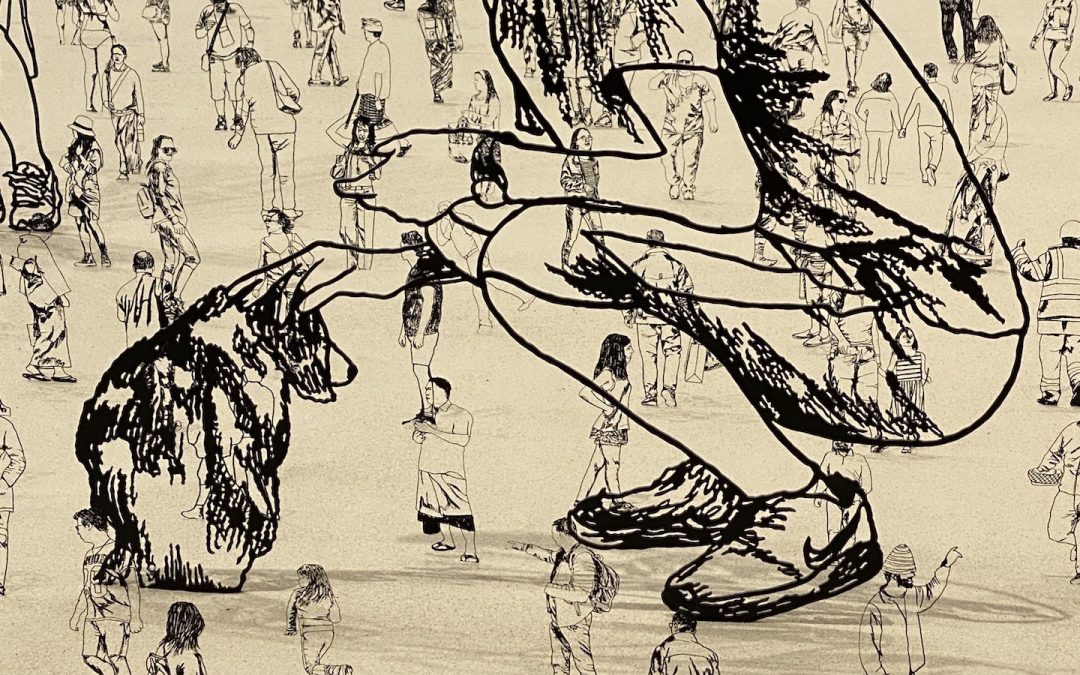“People I Saw but Never Met” was conceived long before the Pandemic, featured at various international galleries more or less in its present format including London, Siberia, Braganca, Portugal, Seoul, and Los Angeles, and is the result of over a decade of research and exploration. The artist has long been fascinated by multiplicity, using it as an organizing principle to consider both flora and fauna, and likes to provoke the viewer to consider his or her own relationship to the environments exhibited. The fact that this particular manifestation is placed is centered within the enormous main gallery on the ground level of the museum, enabling the viewer to walk all the way around its periphery, taking it in from each and every angle, makes the experience both more powerful and personal.
Of course, the figures themselves are responsible for the high level of engagement inspired by the installation. They are each based on people Ben-David actually saw during his travels around the world but with whom, as he makes clear, he never spoke. They include those found close to his homes in London and Tel Aviv as well as numerous individuals from far-flung continents (including Antarctica) which he has visited. They are meant to offer a representative slice of our world, including a range of social classes and occupations, cultures, and age groups. They represent multiple aspects of daily life and were chosen for reasons as simple as a particular gesture or expression that caught his eye. What is elemental to each, is the way it is unposed and completely natural. Examined closely, the viewer discovers many different versions of his own life: riding a bicycle, bending over to pat a dog, standing arm in arm with a group of friends, digging for crabs on a sandy beach or hailing a cab. The variety of life presented by Ben-David is endless.
The production of this installation involved many stages. The artist began with candid photographs, using them as the basis for simple linear pencil sketches. For the smaller figures, he proceeded by creating etchings, eventually turning each into a thin, metal, cut-out which he then painted black. The larger figures began the same way but were composed of hand-cut aluminum, similarly, painted black. The miniatures are about the height of one’s palm, those in large form measure about one meter tall.
The installation is truly engaging, the familiarity and unfamiliarity of the figures endlessly entertaining. It was a pleasure to see children spread out, belly down, on the floor next to their awkwardly crouched grandparents, gazing straight into the faces of the tiny figures. They seemed especially amazed by this miniature world, pointing at one figure after another, alternately smiling, exclaiming and laughing out loud.
An intriguing aspect of the installation is that it gives the impression of representing a random gathering, it is no such thing. In fact, the artist has arranged all of the figures within a distinct pattern, placing the large ones at regular intervals among the sea of miniatures, each and every one individual represented afforded its own pocket of space, each equidistant from its neighbor. The overall effect is one of measured calm. The viewer is able to take in each, on his own, before moving on to the next. There is no feeling of being overwhelmed despite their vast number. It is when one stands up and starts to circulate around the perimeter that the figures begin to overlap, their silhouettes blending, their identification compromised. It is here that the artist has succeeded in conveying how individuals, are, at the end of the day, part of a whole; that their differences, whether cultural or economic, national or generational, can be erased and forgotten with the blink of an eye.
Ben-David’s installation comes at a critical point in time, directly on the heels of a global pandemic during which social interaction was minimized, leaving many individuals isolated, when borders were closed, disabling people from different countries from getting together, acquainting themselves with new cultures. What he originally intended years ago upon conceiving of this series of works, his original statement regarding global cohesion, cohabitation, and harmony, has become something else entirely.
The natural inclination of the viewer, given our new reality, is to warn the thousands of individuals arranged in the gallery to step back and away, to flee this crowded throng. One experiences the strangest urge to insist that if they are going to stand so close together, they should at least don masks. The pandemic has forever changed our conception of public gatherings, altering our orientation, subverting our natural inclination to engage, and encouraging its opposite, disengagement.
In some ways, Ben-David was almost prescient. For although he depicts his figures standing together in an impossibly crowded arrangement, he allows each and every one a small, but distinct, piece of real estate. This isn’t something one notices when viewing the installation from an angle, but when standing directly in front of any one of the figures, whether miniature or large form, the measured portion of space they’ve each been allotted is obvious. Amazingly enough, within the crowded morass of humanity gathered, individuals have each been awarded a distinct area to call their own. While this may not be the suggested “six-feet,” it still feels significant.
In the end, Zadok Ben-David’s installation at the Tel Aviv Museum of Art feels both contemporary and relevant. As a call for inclusion and coexistence within healthy limits, it becomes a perfect memorial to 2020.



Wow! Running to see this!
Fascinating review & installation. Really enjoyed your ‘new’ perspective of a pre-pandemic concept! Love it!
I so wish that I could stop by and see this exhibit (ideally with you.) Your descriptions of it are fascinating